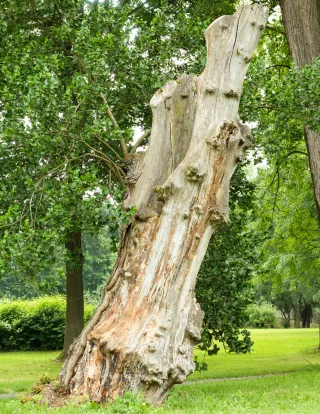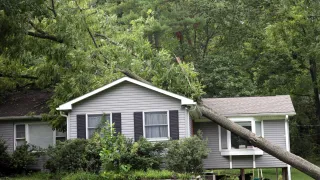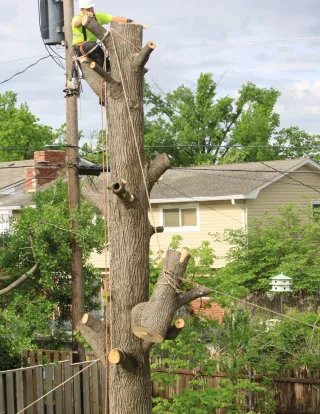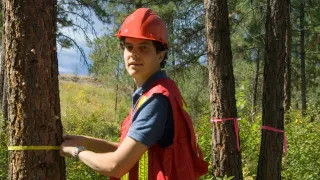
Protecting Your Trees from Fall Storm Season in Tennessee
Fall storm season in Tennessee isn't as predictable as spring, but it can be just as destructive. September through November brings everything from severe thunderstorms to early ice events, and your trees deal with different stresses than they face in spring storms. I've cleaned up after enough fall storms to know that preparation makes a huge difference in how well trees survive.
The challenge with fall storms is that trees are transitioning to dormancy – they're not in their strongest, most flexible state, but they're also not fully dormant yet. That in-between period can make them more vulnerable to certain types of damage.
What Makes Fall Storms Different
Spring storms hit trees that are actively growing and full of sap – they're flexible but also more likely to break cleanly if they do fail. Fall storms hit trees that are shutting down for winter – less flexible, but also less likely to bleed heavily from wounds.
Wind patterns are different too. Fall storms often come with temperature changes that make wind behavior less predictable. Cold fronts can bring sudden, intense winds that trees weren't "expecting" based on earlier weather.
Ice is a bigger concern in late fall. Even a small amount of ice can add tremendous weight to branches that still have leaves, creating loads that wouldn't exist once trees are fully dormant.
Identifying Vulnerable Trees
Trees that struggled this summer are more vulnerable to fall storm damage. Drought stress, pest problems, or disease issues leave trees with less energy to handle additional stress.
Species that hold onto leaves longer face more ice loading risk. Oaks, some maples, and Bradford pears often keep leaves well into November, making them more susceptible to ice damage.
Trees with structural problems that weren't obvious during growing season become more apparent as leaves thin out. Co-dominant stems, weak branch attachments, and internal decay show up more clearly in fall.
Recently planted or transplanted trees haven't established root systems that can handle storm stresses as well as established trees.
Preventive Pruning: What Works and When
Early fall pruning (September-October) can address obvious hazards before major storm season, but it needs to be targeted:
Remove dead, diseased, or obviously weak branches – these will fail eventually, and it's better to remove them on your schedule than wait for storms to do it.
Address branches that are already cracked or split from summer storms – these are likely to fail completely with additional stress.
Remove water sprouts and suckers that grew rapidly this year – they're usually weakly attached and vulnerable to wind damage.
What not to do: Don't do major structural pruning in fall. Save heavy pruning for dormant season when trees can handle the stress better.
Root Zone Protection
Root health affects storm resistance more than most people realize. Trees with strong, deep root systems handle wind loads much better than trees with compromised roots.
Avoid soil compaction around trees, especially during wet fall weather when soil is more vulnerable to compaction.
Don't pile leaves directly against tree trunks – this can create moisture problems that weaken the root collar area.
Address drainage issues before winter. Standing water around trees weakens root systems and makes trees more likely to fail in storms.
The Ice Storm Factor
Ice storms are Tennessee's most destructive tree events, and they're more likely in fall when trees still have leaves. Even a quarter-inch of ice can add thousands of pounds of weight to tree canopies.
Trees most vulnerable to ice damage:
Species that hold leaves late (oaks, some maples)
Trees with dense canopies (Bradford pears, some evergreens)
Trees with co-dominant stems or weak branch structure
Fast-growing species with soft wood
You can't ice-proof trees, but you can reduce vulnerable areas through selective pruning before ice season arrives.
Emergency Preparation
Before storms hit, identify trees that could cause problems if they fail:
Trees or large branches over houses, cars, or walkways
Trees near power lines
Trees with obvious structural problems
Large trees that could block driveways or roads
Have contact information ready for tree services, utility companies, and insurance companies. During storm emergencies, everyone gets busy fast.
Know your limitations – storm cleanup often involves dangerous situations that require professional equipment and experience.
During Storm Events
Stay inside and away from windows during severe weather. More people are hurt by storm damage than by the storms themselves.
Don't go outside during ice storms – falling ice and branches are extremely dangerous, and conditions change rapidly.
If you lose power due to tree damage, assume all downed lines are energized and stay well away from them.
Document damage with photos once it's safe to go outside, but don't get close to damaged trees that might still be unstable.
Post-Storm Assessment
Not all storm damage needs immediate attention, but safety hazards do:
Immediate concerns:
Hanging branches or partially failed trees
Trees or branches on structures, vehicles, or power lines
Trees blocking emergency access routes
Obviously unstable trees that could fall without warning
Can wait for professional assessment:
Bark damage or minor branch breaks
Trees that are leaning but stable
Cosmetic damage that doesn't affect structure
Small debris cleanup
Common Post-Storm Mistakes
Don't top damaged trees thinking it will prevent future problems. Topping creates more problems than it solves and leaves trees more vulnerable to future storm damage.
Don't try to remove large branches yourself – storm-damaged trees are unpredictable, and even experienced professionals use special techniques and equipment.
Don't ignore apparently minor damage that could be hiding structural problems. What looks like surface damage sometimes indicates deeper issues.
Don't rush major pruning decisions immediately after storms. Give yourself time to assess what the tree can recover from naturally.
Insurance and Documentation
Document everything before you move or remove damaged material. Insurance adjusters need to see the damage in context.
Get professional assessment for any damage involving structures or major trees. Insurance companies often require professional evaluation for coverage decisions.
Understand your coverage before you need it. Many policies cover removal of trees that damage structures but not removal of trees that just fall in your yard.
Keep receipts for emergency tree services – some insurance policies reimburse storm cleanup costs even if they don't cover the tree damage itself.
Long-Term Storm Resistance
Healthy trees survive storms better than stressed trees. Regular maintenance, proper watering, and addressing problems early all contribute to storm resistance.
Species selection matters for new plantings. Native trees adapted to Tennessee weather patterns generally handle storms better than non-native species.
Proper planting and establishment create strong root systems that improve long-term storm resistance.
Regular professional assessment can identify developing problems before they become storm vulnerabilities.
When to Call Professionals
Before storms: If you're concerned about specific trees or want professional assessment of storm risks.
During storms: Only for true emergencies involving immediate danger to life or property.
After storms: For any damage involving large trees, structures, power lines, or situations where safety is a concern.
Professional storm response teams have specialized equipment and training for working around damaged trees and power lines safely.
The Reality of Storm Damage
No tree is storm-proof, and sometimes healthy trees fail in severe weather through no fault of the tree or the homeowner. The goal is to minimize preventable damage and handle unavoidable damage safely.
Good storm preparation reduces the chances of damage and makes recovery easier when damage does occur.
Most storm damage is manageable with proper professional help, but attempting to handle complex situations yourself often makes things worse and more expensive.
The Bottom Line
Fall storm season brings unique challenges for trees in Tennessee. Prevention through targeted maintenance and proper preparation makes a huge difference in how well your trees survive severe weather.
Know your trees' vulnerabilities, have emergency contacts ready, and don't hesitate to get professional help for situations that involve safety risks or complex damage.
If you're concerned about how your trees might handle fall storms, or if you want to address obvious vulnerabilities before severe weather season, give us a call or text at (423) 443-4533. Proactive storm preparation is always easier and less expensive than emergency storm response.











